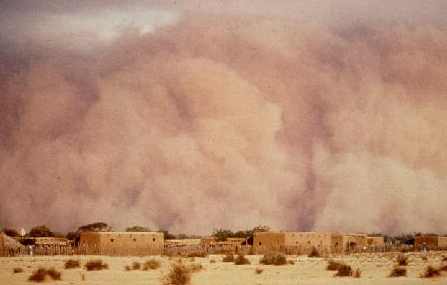 |
 |
| Home | Welcome | What's New | Site Map | Glossary | Weather Doctor Amazon Store | Book Store | Accolades | Email Us |
 | |||||||||
Gone with the WindBlowing sand entered the news headlines in March 2003 when sand- and duststorms added an unwelcome weather element to the Iraq war. Blowing dust and sand are no strangers to the headlines, however. Both the United States and Canada consider the Dust Bowl years of the 1930s and the accompanying black blizzards among the century's most significant weather stories.  African Dust Storm Courtesy of NOAA, US Dept of Commerce The duststorm headlines are not all from distant lands or the distant past. Spread by strong winds, blowing dust affected a wide section of the American Southwest from New Mexico and through much of western Texas in mid-April of 2003. The storm forced road closures and caused a ten-car pileup that killed two. We know that in duststorms and sandstorms, great quantities of dust and sand are carried by the wind. How does it get born aloft? Dust borne on the wind is with us almost all the time. Aeolian or Eolian transport (after Aeolus, a Greek god of the wind) is the term used to describe particles carried by the wind and are held aloft through suspension. The Aeolian process usually starts when strong, often gusty, winds cross an arid landscape picking up small particles such as sand, dust, soil and other debris. The wind then moves the particles in one, or a combination, of three ways: suspension, saltation, or creep. SuspensionThe smallest dust particles are carried through the air by suspension. Suspension occurs when the dust is lofted into the air and held there by upward air currents strong enough to support the weight of the particles. Typical surface wind speeds can suspend dust particles with diameters less than 0.2 millimetres (8/1000 inch) and carry them short distances. Severe windstorms, however, can not only hold large particles aloft for some time, but may also push them to very high altitudes, which enhances their travel distance. Under strong winds, suspended dust particles may be lifted thousands of metres upward and drift thousands of kilometres downwind — even crossing the oceans. SaltationThe term "saltation" comes from the Latin word for "leaping," an apt description of what dust and sand particles do at high wind speeds. In saltation, the particles advance forward through a series of jumps or skips, like a game of progressive leap-tag. The wind lifts the first particle into the air to a height of around a metre or two (3-7 ft). Those particles too heavy to remain suspended, drift downwind a distance of approximately four times the height they attained above the ground (e.g., one metre up moves four metres downwind). When they return to earth, many will hit another particle, causing it to jump up and forward, like tiddley-winks. Now we often have both the original and a struck particle leaping from the ground and moving downwind, and in a chain reaction, they will continue the saltation process as long as the wind speeds remain high. If the leap is sufficiently high, the particle may then become suspended and be pushed higher and farther along. When viewed from a distance, a field of saltating particles appears as if they are constantly suspended, creating a fuzzy layer next to the ground. Note that I have not assigned any wind velocities to saltation and suspension. That is because the particle size and density factor into the equation. I can say that the ability of wind to lift and move particles varies as the cube of the wind's speed. Thus, if the wind speed doubles, it is eight times more effective in moving particles; tripling the wind gives a twenty-seven-fold increase to its ability. Therefore, under storm- and hurricane-force winds, even large objects such as bricks can be sent dangerously airborne.  Means Whereby Wind Blows Surface Dust ParticlesCreepWhen saltating particles strike particles too heavy to bump aloft, they may only nudge the larger grains (up to six times larger than saltating particles) along, a slow sliding and rolling movement known as creep. Creep usually requires wind speed exceeding 16 km/h (10 mph) to impart enough energy to the saltating particle to cause it to move the larger one. Dirty StormsIf lofted dust forms a large cloud that sweeps forward across large areas, the blowing-dust event can be called a duststorm. Meteorological events can cause duststorms generally fall into two main categories: localized convective events and large-scale, non-convective events. Convective-event duststorms arise during strong thunderstorm outflow or downburst winds. The duration of duststorms depends on the lifetime of the process causing them. A microburst duststorm may last only a few seconds, whereas one lofted by a downburst may last several minutes. Dust storms caused by dry squall-line winds or derechos may last many hours. Convective event dust storms are usually most common during the late afternoon in spring and summer when daytime heating is at its peak and are far less predictable than the large scale non-convective events. Large-scale, non-convective duststorm events form under sustained high surface winds associated with cyclonic windstorms. Such duststorms can last from three to four hours, or they may last for several days, depending on the overriding weather situation. These duststorms generally occur in late winter or early spring when extreme pressure gradients produce high wind speeds and surfaces are dry and bare. Approximately two thirds of all duststorms are associated with the passage of fronts and pressure troughs. Learn More From These Relevant Books
|
|||||||||
 |
To Purchase Notecard, |
Now Available! Order Today! | |
 |
 |
NEW! Now Available in the US! |
The BC Weather Book: |


